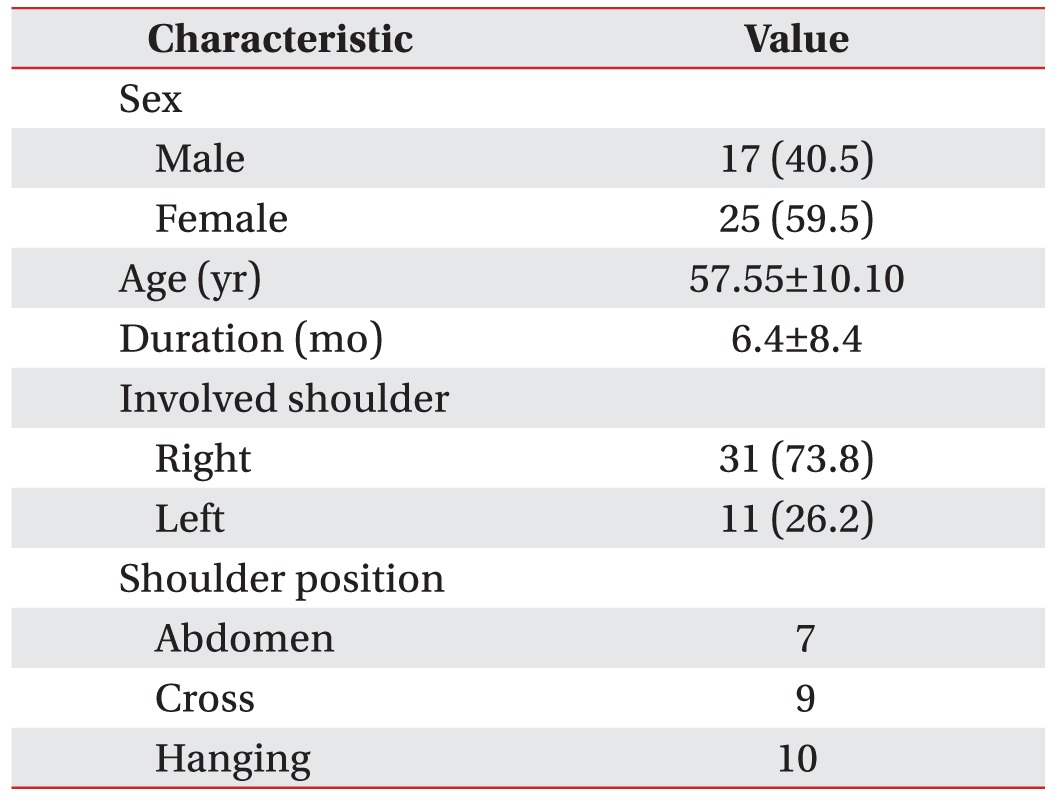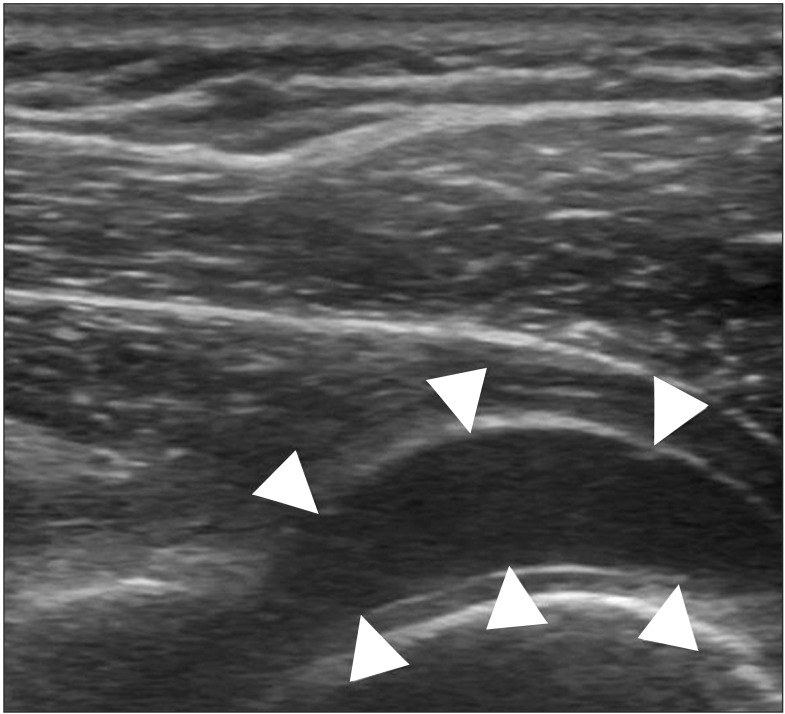1. Grey RG. The natural history of "idiopathic" frozen shoulder. J Bone Joint Surg Am. 1978; 60:564. PMID:
670287.

2. Neviaser JS. Adhesive capsulitis and the stiff and painful shoulder. Orthop Clin North Am. 1980; 11:327–331. PMID:
7001312.

3. Binder AI, Bulgen DY, Hazleman BL, Roberts S. Frozen shoulder: a long-term prospective study. Ann Rheum Dis. 1984; 43:361–364. PMID:
6742896.

4. Murnaghan JP. Adhesive capsulitis of the shoulder: current concepts and treatment. Orthopedics. 1988; 11:153–158. PMID:
3281152.

5. Stitik TP, Foye PM, Fossati J. Shoulder injections for osteoarthritis and other disorders. Phys Med Rehabil Clin N Am. 2004; 15:407–446. PMID:
15145424.

6. Shah N, Lewis M. Shoulder adhesive capsulitis: systematic review of randomized trials using multiple corticosteroid injections. Br J Gen Pract. 2007; 57:662–667. PMID:
17688763.
7. Valls R, Melloni P. Sonographic guidance of needle position for MR arthrography of the shoulder. AJR Am J Roentgenol. 1997; 169:845–847. PMID:
9275909.

8. Vierola H. Ultrasonography-guided contrast media injection to shoulder joint using a posterior approach: a technique worth trying. Acta Radiol. 2004; 45:616–617. PMID:
15587417.

9. Zwar RB, Read JW, Noakes JB. Sonographically guided glenohumeral joint injection. AJR Am J Roentgenol. 2004; 183:48–50. PMID:
15208107.

10. Neethling-du Toit M, de Villiers R. Anterior approach v. posterior approach-ultrasound-guided shoulder arthrogram injection. S Afr J Radiol. 2008; 12:60–62.
11. Kim MW, Kim JS, Ko YJ, Lee WI, Kim JM, Yun JS. Ultrasonography guided glenohumeral injection using an anterior approach: a cadaveric study. J Korean Acad Rehabil Med. 2009; 33:215–218.
12. Park KD, Nam HS, Kim TK, Kang SH, Lim MH, Park Y. Comparison of sono-guided capsular distension with fluoroscopically capsular distension in adhesive capsulitis of shoulder. Ann Rehabil Med. 2012; 36:88–97. PMID:
22506240.

13. Hannafin JA, Chiaia TA. Adhesive capsulitis. A treatment approach. Clin Orthop Relat Res. 2000; (372):95–109. PMID:
10738419.
14. Breglio L. A system of orthopaedic medicine. J Hand Ther. 1996; 9:412–413.
15. Tveita EK, Ekeberg OM, Juel NG, Bautz-Holter E. Range of shoulder motion in patients with adhesive capsulitis; intra-tester reproducibility is acceptable for group comparisons. BMC Musculoskelet Disord. 2008; 9:49. PMID:
18405388.

16. Tveita EK, Tariq R, Sesseng S, Juel NG, Bautz-Holter E. Hydrodilatation, corticosteroids and adhesive capsulitis: a randomized controlled trial. BMC Musculoskelet Disord. 2008; 9:53. PMID:
18423042.

17. Arslan S, Celiker R. Comparison of the efficacy of local corticosteroid injection and physical therapy for the treatment of adhesive capsulitis. Rheumatol Int. 2001; 21:20–23. PMID:
11678298.
18. Yun YH, Mendoza TR, Heo DS, Yoo T, Heo BY, Park HA, et al. Development of a cancer pain assessment tool in Korea: a validation study of a Korean version of the brief pain inventory. Oncology. 2004; 66:439–444. PMID:
15452372.

19. Roach KE, Budiman-Mak E, Songsiridej N, Lertratanakul Y. Development of a shoulder pain and disability index. Arthritis Care Res. 1991; 4:143–149. PMID:
11188601.

20. Woodward TW, Best TM. The painful shoulder: part I. Clinical evaluation. Am Fam Physician. 2000; 61:3079–3088. PMID:
10839557.
21. Tyler TF, Roy T, Nicholas SJ, Gleim GW. Reliability and validity of a new method of measuring posterior shoulder tightness. J Orthop Sports Phys Ther. 1999; 29:262–269. discussion 270-4. PMID:
10342563.

22. Tyler TF, Nicholas SJ, Roy T, Gleim GW. Quantification of posterior capsule tightness and motion loss in patients with shoulder impingement. Am J Sports Med. 2000; 28:668–673. PMID:
11032222.

23. Tobola A, Cook C, Cassas KJ, Hawkins RJ, Wienke JR, Tolan S, et al. Accuracy of glenohumeral joint injections: comparing approach and experience of provider. J Shoulder Elbow Surg. 2011; 20:1147–1154. PMID:
21493103.






 PDF
PDF ePub
ePub Citation
Citation Print
Print










 XML Download
XML Download